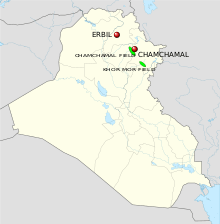Pearl Petroleum
 | |
| Industry | Oil and Gas |
|---|---|
| Founded | 2009 |
Area served | Kurdistan region of Iraq |
| Website | www.pearlpetroleum.com |
Pearl Petroleum is a five-company consortium consisting of two Middle Eastern oil and gas companies: Dana Gas and Crescent Petroleum, in partnership with three major European energy companies OMV, MOL, and RWE. Pearl Petroleum produces and develops natural gas assets in the Kurdistan region of Iraq.[1]
History
Pearl Petroleum ownership (2016)
In 2007, Dana Gas and the Kurdistan Regional Government (KRG) in Iraq signed an agreement to develop the Khor Mor and Chemchemal fields — two major gas fields in the region.[2] As per the agreement, Crescent Petroleum and Dana Gas were given exclusive rights to appraise, develop, process, market and sell petroleum from the Khor Mor and Chamchamal blocks. The project primarily provides natural gas supplies to electricity power generation plants in Erbil and Chamchamal, as well as for domestic gas consumption and export.[2]
Pearl Petroleum was founded in 2009 as a joint venture between Dana Gas and Crescent Petroleum. Later in 2009, OMV of Austria and MOL of Hungary, two major European energy companies, each became 10% shareholders in Pearl Petroleum.[3] In 2015, German company RWEST acquired a 10% share in the company.[4]
In 2015, Crescent Petroleum and Dana Gas won a court case against the KRG in the UK over a long-standing dispute regarding the company's rights to sell shares and payment for the production petroleum products.[5]
Operations

Pearl Petroleum is one of the largest private investors in the Kurdistan region in the oil and gas sector. It indirectly provides electricity supply to over four million people in Iraq.[6] In addition to increasing gas supply for domestic market and industry use, Pearl Petroleum also exports to foreign markets.
The first stage of the commissioning of the Khor Mor field begun by recommissioning existing gas wells, building gas separation and treatment facilities, and the construction of 180 kilometres (112 mi)s of pipeline.[6] The first gas supply to the Erbil plant commenced in October 2008. The second stage, completed in 2011, involved the installation of a two-train liquid petroleum gas (LPG) plant with current gas production capacity of 330 MMscf/day.[6]
In a report titled Dana Gas and Crescent Petroleum Gas Project in Kurdistan Region of Iraq : Socio Economic Benefits Report authored by global accounting firm PwC, the savings to Kurdistan Regional government by migrating from diesel to cheaper gas is quantified at USD 15.9 billion since inception.[7] The report further mentions that the project has achieved an average savings of USD 300 million per annum in Greenhouse gas reduction.[7]
See also
References
- ↑ "Pearl consortium seeks $1bn from Kurdistan over gas contract". October 22, 2013. Retrieved 3 July 2016.
- 1 2 "Dana Gas consortium wins pay out case against Kurdistan government in Iraq". Hydrocarbons Technology. Retrieved 3 July 2016.
- ↑ Freifeld, Daniel. "The Great Pipeline Opera". Novinite. Retrieved 15 August 2016.
- ↑ "Dana Gas Agrees Settlement With RWE Unit on Iraq Dispute". Retrieved 3 July 2016.
- ↑ "Kurdish outlay saved costs, says Dana Gas". The National UAE. 6 April 2016. Retrieved 15 August 2016.
- 1 2 3 "Kurdistan Gas Project". Kurdistan Gas Project. Retrieved 3 July 2016.
- 1 2 Dana Gas and Crescent Petroleum Gas Project in Kurdistan Region of Iraq Socio Economic Benefits Report (PDF). PwC. 2015. p. 92. Retrieved 15 August 2016.
